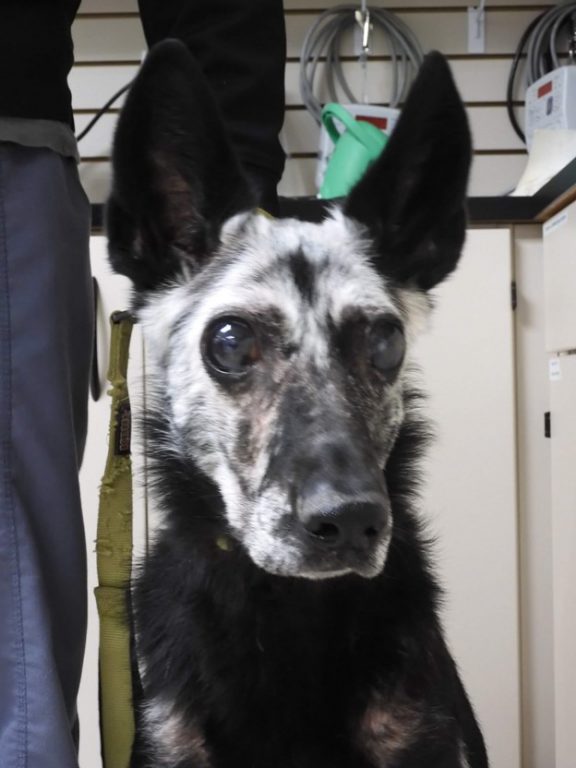
Vela is a lovely and spirited young 4-year-old, spayed, female black German Shepherd that presented for hair coat color change. Over the last two years, her black hair was slowly turning white. The coat color change started on her head and spread like a wave to her head, neck, shoulders, and limbs. There is no inflammation and no lesions on the skin. Vela was blind when she was adopted. The cause of the blindness and change in appearance of the globes of her eyes was not determined. She is active and healthy.
So, the main presenting problem was whitening of the hair coat, leukotrichia. Dr. Pinchbeck considered several potential causes. Uveodermatologic syndrome was the primary differential, as it is an auto-immune disease that affects the skin, hair, and eyes. Other causes of leukotrichia include vitiligo, cutaneous lymphocytosis, cutaneous lymphoma, certain medications, hormonal imbalances, post inflammatory hair coat color changes, and alopecia areata.
Skin punch biopsies were performed and specimens were submitted to a dermatophistopathologist. Alopecia areata was the histologic diagnosis for Vela.
Alopecia Areata
Hair growth involves an intricate and complex cyclical process called the hair cycle. Alopecia areata is an uncommon disease affecting the hair cycle. It can also affect the deposition of melanin (color) into the hair during the cycle. In alopecia areata, the hair cycle is interrupted. It is an immune system mediated event that involves genetics, hormones, environmental factors, and maybe even diet. There is evidence that the hair bulb (base of the hair from which it all grows) melanocytes (cells responsible for depositing pigment into hair) can be a specific target.
Because the hair cycle is targeted and interrupted, alopecia areata typically results in patches of non-inflammatory hair loss (alopecia). The head and face are commonly affected. Dogs tend to be otherwise healthy and younger in age. German Shepherds are an affected breed. About 1/3 of dogs with alopecia areata have leukotrichia at the initial evaluation.
In Vela’s case, it appears the hair bulb melanocytes were the principal target, and the hair cycle was less affected. This resulted in white hairs (leukotrichia) more than loss of hair (alopecia).
The prognosis for Vela is good. Hair growth spontaneously occurs in many (60%) dogs. Some do not regrow hair. Regrowth is often white (75%) and may remain white for many hair cycles. Over time, after several hair cycles, new hairs may be pigmented again.

